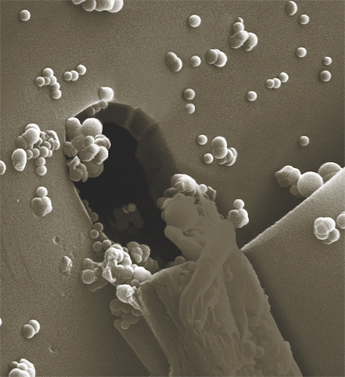Set in a Tiffany & Co. necklace, it sold for $4.2 million, the highest price and price per carat paid for a Paraíba tourmaline at auction.
Gübelin Gem Lab Debuts ‘Emerald Paternity Test’
The new technology introduced at Baselworld can trace an emerald to the mine of its origin.

Introduced at Baselworld 2017, Gübelin’s “Emerald Paternity Test” involves applying DNA-based nanoparticles directly onto rough emerald crystals at mining sites.
Nanotechnology deals with particles less than 100 nanometers large. The particles aren't visible to the naked eye or even under an optical microscope, so a stone’s properties and grading won’t be affected by the application.
Gübelin’s application process is designed to withstand all steps of an emerald’s journey, from cutting to cleaning, polishing, transporting and setting, so that the nanoparticles will act as a permanent origin tag.
Just like a human's DNA is specific to each individual, the tag will be unique to each mine.

“This technology offers all stakeholders along the entire supply chain, from the miner to the final customers, proof of the exact source of emeralds, instilling confidence and creating trust,” said Daniel Nyfeler, managing director of Gübelin Gem Lab. “It enables a new level of transparency for the gemstone trade.”
Gübelin worked with Gemfields, majority owner of the world’s largest emerald mine, the Kagem Mine in Zambia, to test the new technology.
“Partnering with Gemfields for the feasibility study was an obvious choice,” Nyfeler said, “as it is not only an industry leader, but a forward-thinking company, and hence a perfect partner to test a ground-breaking idea such as this paternity test for emeralds.”
The results were a success and Gemfields told National Jeweler it would "continue to tag emerald production coming through the auction system."
Gemfields CEO Ian Harebottle explained, “Embracing innovation, technology and increased transparency is at the heart of our approach. We were therefore thrilled to assist Gübelin in the testing of this new technology, and we are very excited about the outcome as it offers a multitude of benefits to the industry and the consumer.”
For now, the paternity test will only work for emeralds, as the DNA-based nanoparticles are able to adhere to the fissures unique to the gemstone, and remain there through all processing.
Gübelin, which analyzes diamonds, color gemstones and pearls at its laboratories in Lucerne, Switzerland, Hong Kong and New York, said that the nanotechnology could offer transparency across the industry, to large and small mining companies, governments, trade organizations, industry watchdogs, jewelry brands and customers.
Gübelin is "looking to develop relationships with all stakeholders in the supply chain," they said to National Jeweler.
The Latest

The jeweler’s “Deep Freeze” display showcases its iconic jewelry designs frozen in a vintage icebox.

Take luxury gifting to new heights this holiday season with the jeweler’s showstopping 12-carat sphene ring.

How Jewelers of America’s 20 Under 40 are leading to ensure a brighter future for the jewelry industry.

This year's theme is “Unveiling the Depths of the Ocean.”


In its annual report, Pinterest noted an increase in searches for brooches, heirloom jewelry, and ‘80s luxury.

The 111-year-old retailer celebrated the opening of its new location in Salem, New Hampshire, which is its third store in the state.

Roseco’s 704-page catalog showcases new lab-grown diamonds, findings, tools & more—available in print or interactive digital editions.

The new catalog features its most popular chains as well as new styles.

The filmmaker’s personal F.P. Journe “FFC” prototype was the star of Phillips’ recent record-setting watch auction in New York.

The new location in the Design District pays homage to Miami’s Art Deco heritage and its connection to the ocean.

Inflations, tariffs, and politics—including the government shutdown—were among consumers’ top concerns last month.

“Longtime favorite” presenters, as well as first-time speakers, will lead talks and workshops at the annual event in Tucson next year.

Silas Smith of Meridian Metalworks won the challenge with his pendant that blends Australian and American landscapes.

The sale of the 31.68-carat, sunset-hued stone was part of Sotheby’s first series of events and auctions in Abu Dhabi.

Most customers who walk into your store this month have made up their minds. Your job is to validate their choice, Emmanuel Raheb writes.

The collection features characters and motifs from Ukrainian folklore, including an enchanted mirror and a magic egg.

MatrixGold 3.11, the newest version of the jewelry design program, offers more flexibility, precision, and creative control.

The pavilion will be part of the 2026 JA New York Spring show, scheduled for March 15 to 17.

Kadet, a 1994 National Jeweler Retailer Hall of Fame inductee, helped grow the family-owned retailer in the Chicago area and beyond.

Billed as the world’s smallest wearable, Lumia Health’s new smart earrings have a health tracker subtly embedded in the back.

Don’t let those with December birthdays feel blue. Help them celebrate their month with blue zircon, turquoise, and tanzanite.

The new pink sapphire version of the piece dances with its wearer in the brand’s “Icons After Dark” holiday campaign.

A choice that’s generated a lot of commentary, Pantone says “Cloud Dancer” marks a fresh start and encourages relaxation and creativity.

The manufacturer’s holiday campaign features a gift guide filled with trending designs and jewelry that can be personalized.

The man was charged with theft, accused of ingesting the necklace while in a jewelry store in Auckland, New Zealand.

The Florida independent expanded its store from 8,000 to 14,000 square feet, fulfilling the vision of its late co-founder, Jim Dunn.




























